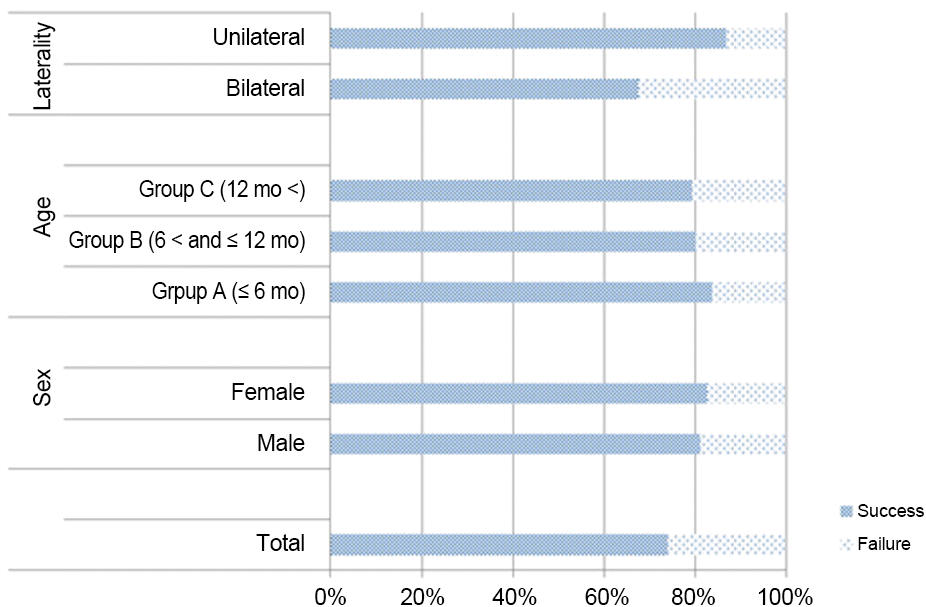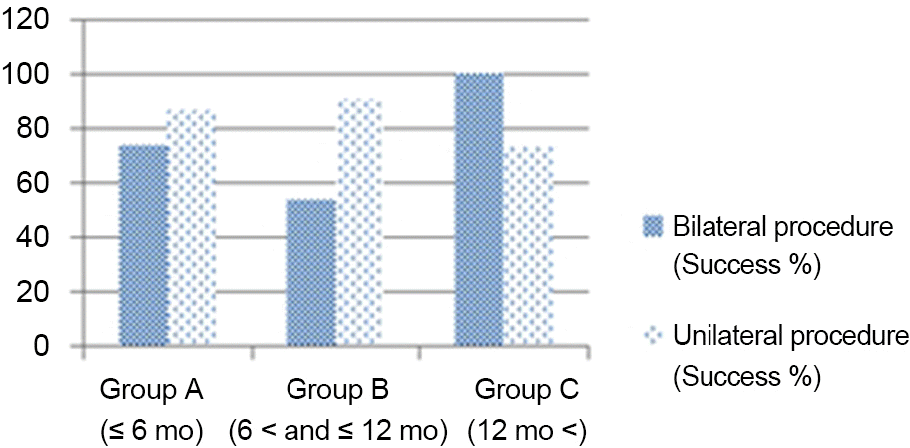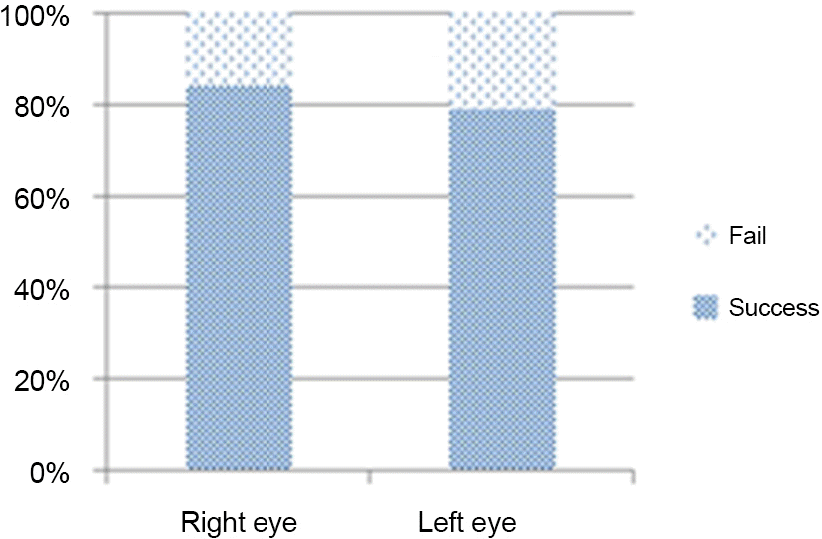Abstract
Purpose
To determine the success rate of probing for the treatment of congenital nasolacrimal duct obstruction and to identify the clinical factors affecting the success rates.
Methods
The records of probing procedures from January 2005 to January 2015 were reviewed. The present study included 200 eyes of 174 patients with congenital nasolacrimal duct obstruction. Successful probing was defined as complete resolution of epiphora 3 months after treatment. Success rates were compared between the 2 groups in terms of sex, age, laterality, and previous probing.
Results
A total of 200 eyes of 174 children (109 eyes of 94 males and 91 eyes of 80 females; mean age, 7.51 ± 3.39 months) had undergone the probing procedure. The overall success rates of primary probing were 81.5%, with an 80.7% success rate in males (88 eyes of 109 eyes) and 82.5% in females (75 eyes of 91 eyes). Success rates were 83.5% for the 91 eyes in children aged 0 to 6 months, 80.0% for the 90 eyes in children 6 to 12 months, and 78.9% for the 19 eyes in children over 12 months. No statistical significances were found among age groups. The probability of treatment success was lower in bilateral disease (p < 0.05; 86.4–67.3%). Twenty-four of 37 eyes with unsuccessful primary probing underwent secondary probing, resulting in a 70.8% success rate. Silicone tube insertion was performed in 4 eyes repeatedly, however, the procedures were unsuccessful. The overall success rate was 90%.
Conclusions
The success rates among various age groups were not statistically significant. The probability of treatment success was lower in bilateral cases. Probing is an effective first-line treatment in children diagnosed with nasolacrimal duct obstruction. Close observation and appropriate treatment should be considered in patients with bilateral disease.
References
1. Guerry D 3rd, Kendig EL Jr. Congenital impatency of the abdominal duct. Arch Ophthal. 1948; 39:193–204.
2. Lee SY, Chung HS, Kim HB, et al. The incidence of congenital abdominal duct obstruction in Korean neonates. J Korean abdominal Soc. 1989; 30:5–8.
3. Oh HS, Ahn Y. The incidence and medical treatment of congenital nasolacrimal duct obstruction in Korean infants. J Korean abdominal Soc. 1995; 36:1007–13.
4. Sevel D. Development and congenital abnormalities of the abdominal apparatus. J Pediatr Ophthalmol Strabismus. 1981; 18:13–9.
5. Katowitz JA, Welsh MG. Timing of initial probing and irrigation in congenital nasolacrimal duct obstruction. Ophthalmology. 1987; 94:698–705.

6. Mannor GE, Rose GE, Frimpong-Ansah K, Ezra E. Factors abdominal the success of nasolacrimal duct probing for congenital abdominal duct obstruction. Am J Ophthalmol. 1999; 127:616–7.
7. Honavar SG, Prakash VE, Rao GN. Outcome of probing for abdominal nasolacrimal duct obstruction in older children. Am J Ophthalmol. 2000; 130:42–8.
8. Gunton KB, Chung CW, Schnall BM, et al. Comparison of balloon dacryocystoplasty to probing as the primary treatment of abdominal nasolacrimal duct obstruction. J AAPOS. 2001; 5:139–42.
9. Robb RM. Success rates of nasolacrimal duct probing at time abdominal after 1 year of age. Ophthalmology. 1998; 105:1307–9. abdominal 1309–10.
10. Kushner BJ. The management of nasolacrimal duct obstruction in children between 18 months and 4 years old. J AAPOS. 1998; 2:57–60.

11. Duck-Elder S. System of Ophthalmology. 1st ed.Vol. 3. St. Louis: C.V. Mosby Co.;1963. p. 923–41.
12. Sevel D. A reappraisal of the origin of human extraocular muscles. Ophthalmology. 1981; 88:1330–8.

13. Kersten RC. Congenital lacrimal abnormalities. Bosniak S, editor. Ophthalmic Plastic and Reconstructive surgery. 2nd ed.Philadelphia: WB Saunders;1996. p. 954.
14. Buerger DG, Schaefer AJ, Campbell CB 3rd, Flanagan JC. Congenital lacrimal disorders. Nesi FA, Lisman RD, Levine MR, editors. Smith's Ophthalmic Plastic and Reconstructive surgery. 2nd ed.St. Louis: Mosby;1998. p. 649–60.
15. Kim CH, Lew HL, Yun YS. The characteristics of infants with abdominal nasolacrimal duct obstruction improved with lacrimal sac digital massage. J Korean Ophthalmol Soc. 2008; 49:1559–64.
16. Ffooks OO. Lacrimal abscess in the newborn: a report of seven cases. Br J Ophthalmol. 1961; 45:562–5.

17. Arora S, Koushan K, Harvey JT. Success rates of primary probing for congenital nasolacrimal obstruction in children. J AAPOS. 2012; 16:173–6.

18. Perveen S, Sufi AR, Rashid S, Khan A. Success rate of probing for congenital nasolacrimal duct obstruction at various ages. J abdominal Vis Res. 2014; 9:60–4.
19. Hung CH, Chen YC, Lin SL, Chen WL. Nasolacrimal duct probing under topical anesthesia for congenital nasolacrimal duct abdominal in Taiwan. Pediatr Neonatol. 2015; 56:402–7.
20. Limbu B, Akin M, Saiju R. Age-based comparison of successful probing in Nepalese children with nasolacrimal duct obstruction. Orbit. 2010; 29:16–20.

21. Zilelioğ lu G, Hoş al BM. The results of late probing in congenital nasolacrimal duct obstruction. Orbit. 2007; 26:1–3.

22. Lee JJ, Ahn JH, Kim JL, Yang JW. The clinical outcome of abdominal silicone tube intubation for congenital nasolacrimal duct obstruction. J Korean Ophthalmol Soc. 2012; 53:929–33.
Figure 1.
Primary probing success rate according to laterality, age, sex. Success; as complete resolution of epiphora 3months after first probing. mo = months.

Figure 2.
Primary probing success rate according to laterality, age. Bilateral procedure; probing was performed at both nasolacrimal duct.

Figure 3.
Primary probing success rate of each eye. Success; as complete resolution of epiphora 3months after first probing.

Table 1.
Demographic/clinical characteristics in various age groups
| Group A (≤ 6 months) | Group B (6 months < and ≤ 12 months) | Group C (12 months <) | Total | p-value* | |
|---|---|---|---|---|---|
| Age (years) | 5.07 ± 1.31 | 8.37 ± 1.43 | 15.42 ± 2.54 | 7.51 ± 3.39 | |
| Patient-level characteristics | N = 80 | N = 77 | N = 17 | 174 | |
| Sex (male:female) | 44:36 | 41:36 | 9:8 | 94:80 | 0.972 |
| Eye-level characteristics | N = 91 | N = 90 | N = 19 | 200 | |
| Laterality | 0.674 | ||||
| Unilateral (%) | 69 (75.8) | 64 (82.2) | 15 (78.9) | 148 (74) | |
| Bilateral (%) | 22 (24.2) | 26 (17.8) | 4 (21.1) | 52 (26) | |
| Previous massage (N = 48) | 0.142 | ||||
| Yes (%) | 31 (34.1) | 22 (24.4) | 8 (42.1) | 61 (30.5) | |
| No (%) | 10 (11.0) | 9 (10.0) | 3 (15.8) | 22 (11.0) | |
| Not known/no record | 50 (54.9) | 59 (65.6) | 8 (42.1) | 117 (58.5) | |
| Epiphora present (N = 200) | 91 | 90 | 19 | 200 | |
| Mucous discharge present (N = 59) | 24 | 31 | 4 | 59 | |
| Culture (N = 29) | 16 | ||||
| Staphylococcus aureus | 4 | ||||
| Streptococcus pneumoniae | 4 | ||||
| Moraxella catahalis | 4 | ||||
| Coagulase-Negative staphylococcus | 4 |
Table 2.
Association between probing time and laterality
| At the time of procedure | Bilateral (success, %) | Unilateral (success, %) | Total (success, %) | p-value* |
|---|---|---|---|---|
| Group A (≤6 months) | 17/22 (77.2) | 59/69 (85.5) | 76/91 (83.5) | 0.22 |
| Group B (6 <and ≤ 12 months) | 14/26 (50) | 58/64 (90.6) | 72/90 (80) | <0.05 |
| Group C (12 months <) | 4/4 (100) | 11/15 (73.3) | 15/19 (78.9) | 5.30 |
| Total | 35/52 (67.3) | 128/148 (86.4) | 163/200 (81.5) | <0.05 |
Table 3.
Clinical outcome success according to baseline eye-level characteristics
| N | Success (%) | Relative risk for fail* | |
|---|---|---|---|
| Sex | |||
| Male | 109 | 88 (80.7) | – |
| Female | 91 | 75 (82.4) | 0.894 |
| Age at probing | |||
| Group A (0 to ≤ 6 months) | 91 | 76 (83.5) | – |
| Group B (6 to ≤ 12 months) | 90 | 72 (80.0) | 0.740 |
| Group C (12 months <) | 19 | 15 (78.9) | 0.938 |
| Laterality | |||
| Unilateral | 148 | 128 (86.4) | – |
| Bilateral | 52 | 35 (67.3) | 3.465 |
| Total | 200 | 163 (81.5) |
Table 4.
Result of 200 eyes probing in various age groups




 PDF
PDF ePub
ePub Citation
Citation Print
Print


 XML Download
XML Download